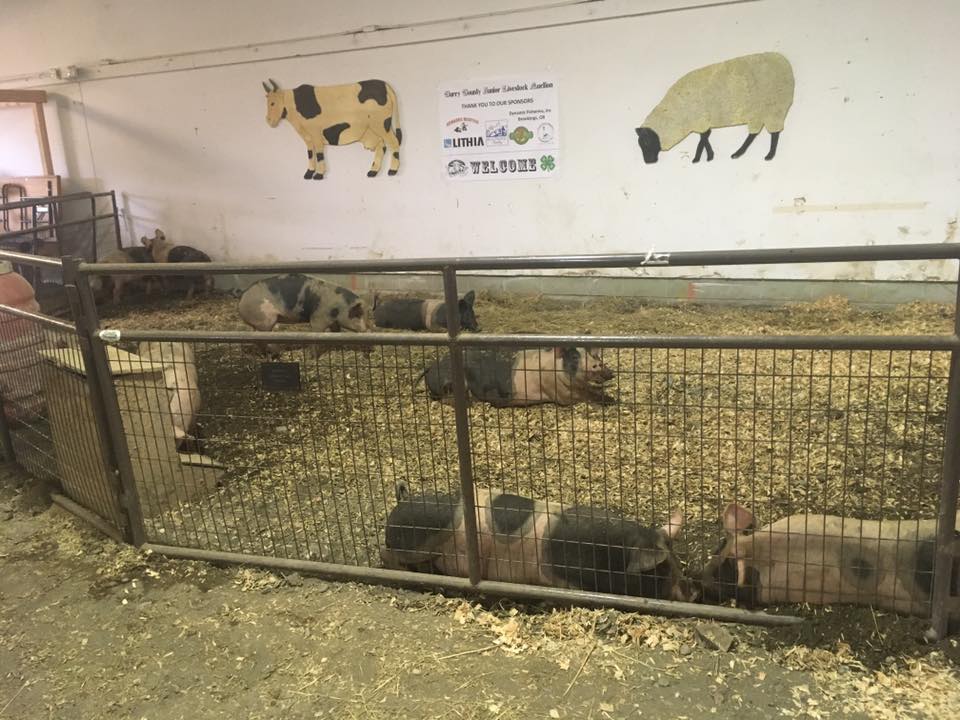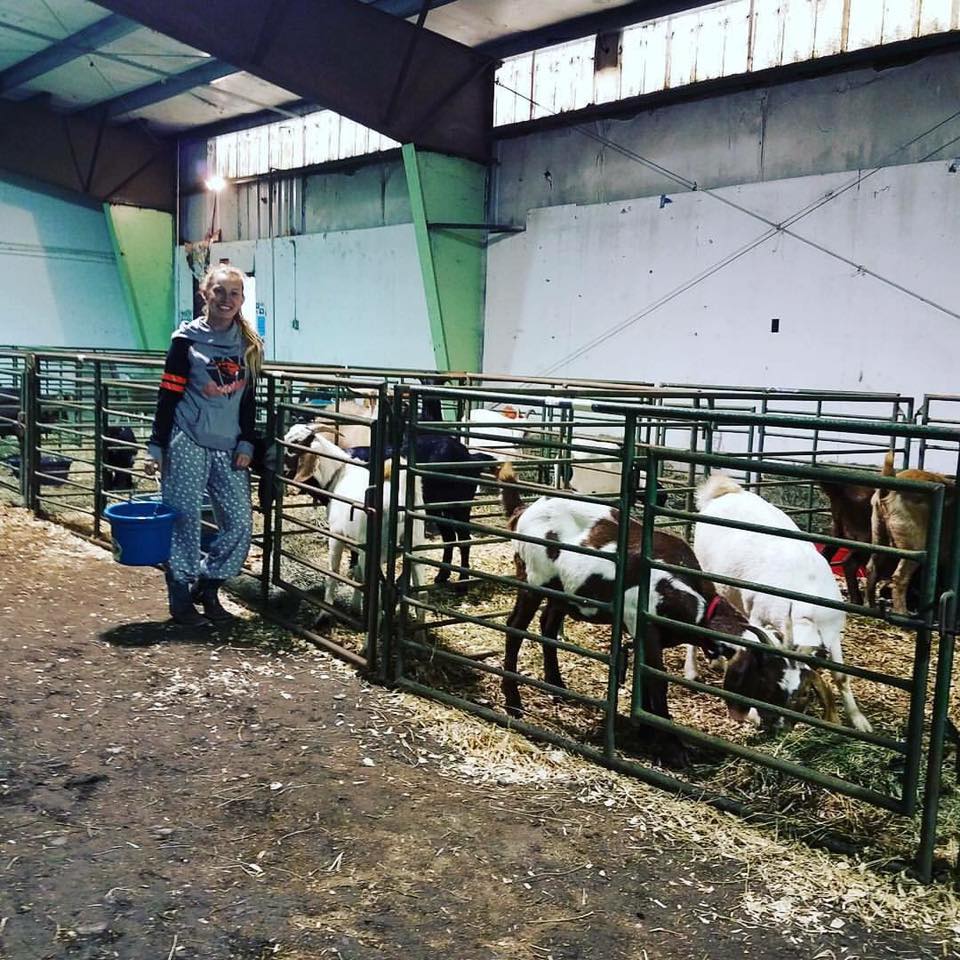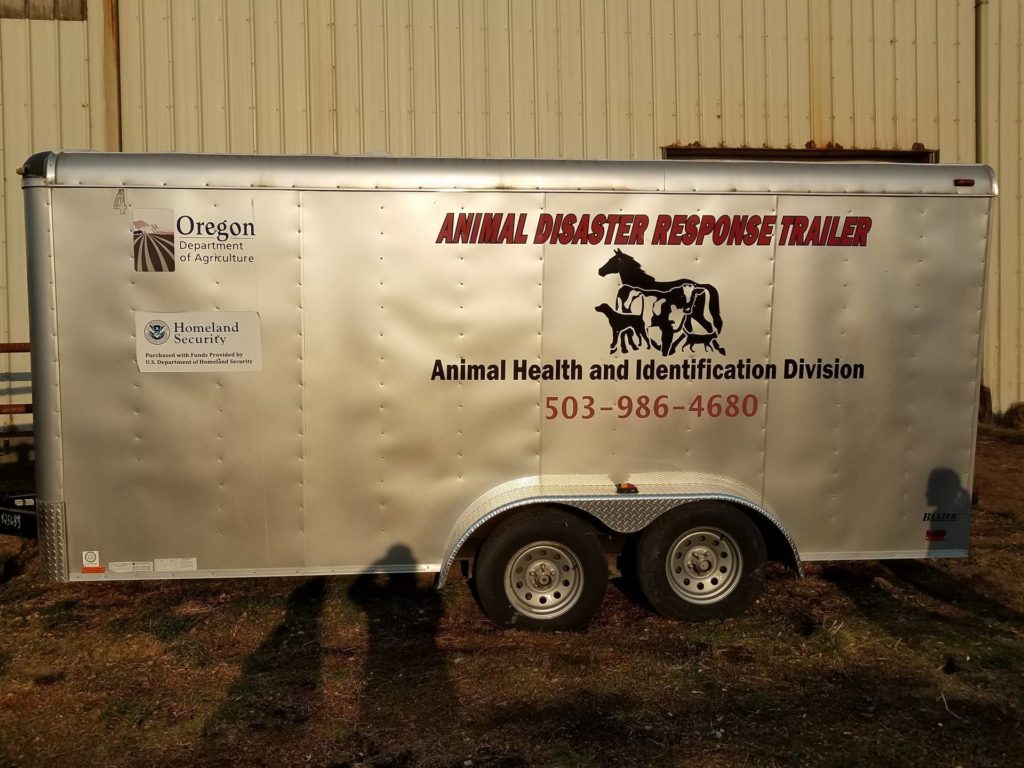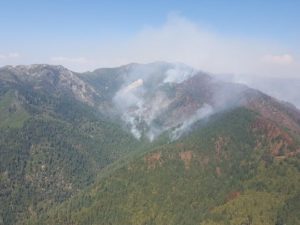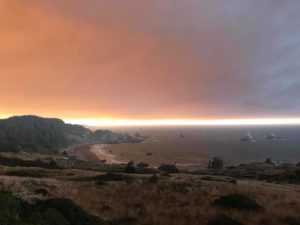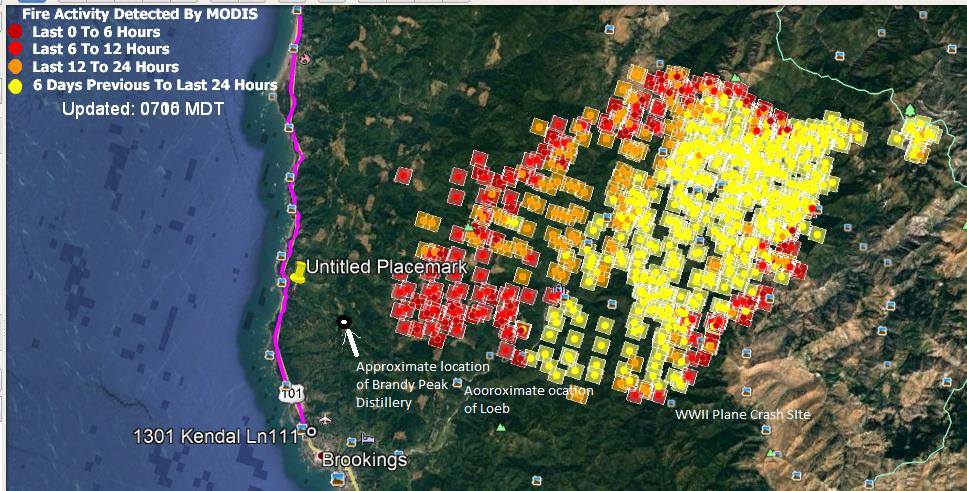Chetco Bar Fire Stories: A Safe Place for the Animals
A Safe Place for the Animals
On August 19 Ruth Leming Dixon, 4-H Educational Program Assistant in Gold Beach, had just started a week of vacation. She was horseback riding with her friend and 4-H leader, Megan Boardman, when Megan received a text message asking for help evacuating horses off Gardner Ridge. Ruth went along to help.
Little did she know, this was just the beginning.
That first group of horses was able to go to private pastures in and around Brookings. But by 3:00 a.m. on Sunday morning, August 20, the need to open up the livestock pavilion at the Curry County fairgrounds became apparent. Ruth explained, “That was when we got the call that one family’s entire menagerie needed to be evacuated – 15 hogs, 2 goats, and an unknown number of chickens, geese and pigeons!”
Ruth reached out to 4-H alumni, and those with trailers agreed to meet at the bottom of that family’s mountain road. “Because the driveway wasn’t big enough for all of us to go up, load, and turn around, we left the rigs at the bottom and went the rest of the way on foot. We decided to take the pigs that night, and the owners would transport the other animals once the sun came up. The volunteers and owners then walked the pigs down to the trailers… it was quite a sight to see in the glow of many flashlights!”
Ruth wasn’t the only one evacuating livestock in the dark that weekend.
Herding a group of piglets – one small one tucked under her arm – as she led the 500 lb. mama pig down a long, dark road with bits of grain was not how Michelle Carrillo had envisioned her weekend turning out. But there she was, at 3:00 a.m. on that same dark Sunday morning, leading her group of mama pig and piglets down the mile-long road to trailers to transport them to safety.
Where do we TAKE all these animals?
The rescuers quickly realized that they needed a place to put all these animals, so they tapped into their network. “One of the folks helping that Sunday was Rob Carrillo, a board member for the county fairgrounds in Gold Beach, so he made an executive decision to let us open up the livestock pavilion right then,” Ruth explained, “And it basically took off from there. Before we knew it, we were in the business of coordinating the evacuation, housing, feeding, and keeping track of, just about every cow, horse, goat, pig, chicken – even some dogs and cats – in and around Brookings that needed our help while the Chetco Bar Fire raged on!”
Ruth became the lead for evacuated livestock, horses and pets, not only those brought to the Curry County Fairgrounds during the fire, but those brought to private pastures and, later on during the emergency, those who went across state lines to the Del Norte Fairgrounds in Crescent City.
Coordinating It All
Most of this coordination took place by phone or via a Facebook page set up by 4-H Alum Jessica Altore called “Chetco Bar Fire Livestock, Horses & Pets.” Jessica, Chris Brose, and Ruth acted as administrators for the page. (The page still exists, but with a new name now: “Curry County Horse, Livestock & Pet Disaster Support”.)
Ruth volunteered throughout her week of vacation, and then continued to coordinate from her desk at the Curry County Extension Office. She continued volunteering after work hours.
Ruth wasn’t alone. “My friends, 4-H contacts, and the livestock community rallied around each other and made this massive animal evacuation work,” Ruth explains. ”We all knew that folks just were NOT going to get themselves safe until they’d made sure their animals were, so we pitched in to give them that reassurance.”
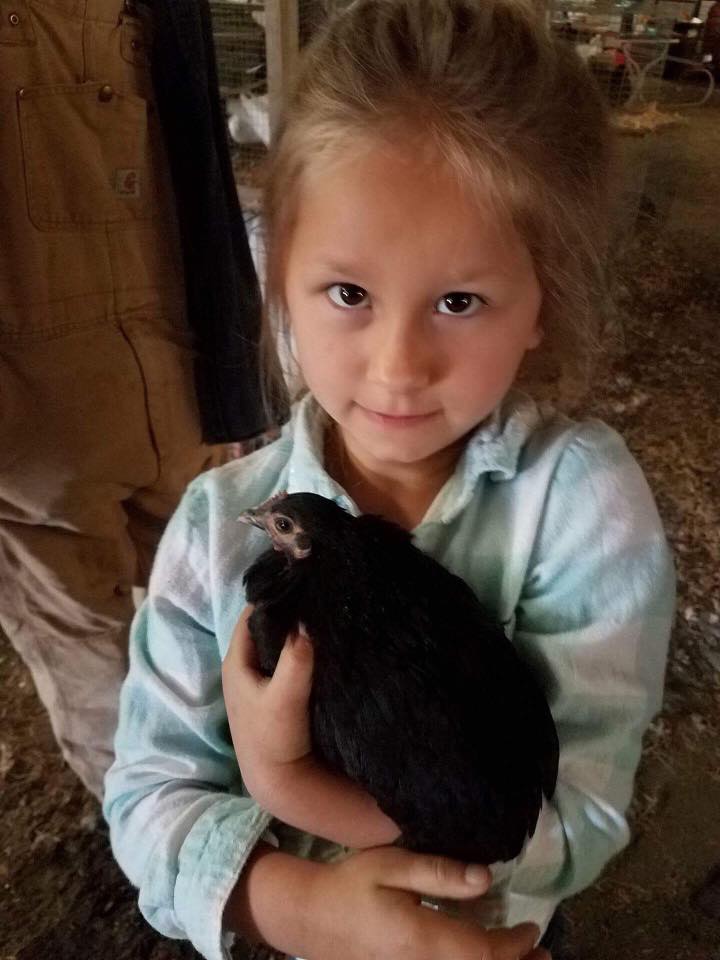
Annaliese Carrillo helps with evacuated chickens at the fairgrounds. Photo courtesy of Michelle Carrillo.
Many Helping Hands
Brittany Scott, a 4-H member, stayed overnight in the Curry County Fairgrounds livestock pavilion with the animals for 24 days straight. (See video from The World of Brittany Scott at the end of this story). Trish Jordan, a 4-H leader, came down from Bandon and assisted. Gary Hoenie, one of the maintenance personnel at the Curry Fairgrounds, helped out wherever he could. Ryan Scholz, the ODA district veterinarian, helped Ruth work through the rules needed to get horses across the California state line, and was the one who suggested Ruth look into obtaining resources from Curry County. Coos Forest Patrol employees Brett Weidemiller and Justin Coleman, along with their crews, were a huge help at the pavilion, setting up, cleaning, and breaking down stalls. Douglas County loaned Curry County their Community Emergency Response Team (CERT) animal trailer for the duration of the emergency.
By the second week, Retired Emergency Services Manager (ESM) Don Kendall stepped in to help, along with Sherrie Ward (from the County ESM office). Wild Rivers Community Foundation and Michelle Carrillo helped Ruth direct donations for the animals where they were needed. Donated or discounted supplies came in from companies like Bandon Feed & Rescue, Gold Beach Lumber, and Colby at Troxel Hay Sales.
The Challenges
This massive livestock evacuation did not come without challenges. Animals would sometimes come in without any owner info, making it really hard to keep track of them while they were being cared for. Ruth also mentions that their coordination could have been smoother had they started out using digital media, rather than putting sticky notes all over the place; more back-office support would have been useful as well.
Ruth noticed that it was hard to keep the momentum going after the crisis was over, which could make it a challenge to be prepared the next time a disaster hits. It also would have helped to know what resources – financial and otherwise – were available before they were in crisis mode. With that said, many lessons have been learned. “At least now we know we need a CERT animal training for the next crisis,” Ruth said.
Preparing for the Next Time
Michelle Carrillo also noted that relocating livestock to various locations for safe keeping basically worked out. However, this was a wake-up call as to how ill prepared we were as a community for an event of this nature. In her opinion, there need to be community plans for the removal of animals or livestock to designated shelters, as well as the care and feeding of them.
Fortunately, this time, it was the local knowledge and connections of volunteers like Ruth and Michelle who could find landowners willing to accept these animals at a moment’s notice, as well as the network of 4-H members with the experience, skills, and trailers that could round up and transport them to safer locations, that made everything work.
Community Values
Despite the gaps and challenges, Ruth came away from the Chetco Bar Fire with a sense of reassurance that people will help one another…AND their animals. “I watched our communities – all of them – draw together, and that did a lot to reassure me that we would take care of each other in the event of another disaster,” Ruth said.
The experience of being a part of the immediate call to action, seeing so many people showing up to help, and just getting things done, also gave Michelle a “re-grounding” in the value of basics. The basics of just rolling up your sleeves and helping, “dropping all the crap” that gets in the way of kindness, and knowing that your community is there. Those feelings still uplift her today.
Ruth Leming Dixon, 4H Educational Assistant, was interviewed on Nov. 20, 2017 by Kathleen Dickson. Michelle Carrillo, Building Healthy Communities Director (and former 4H Director) was interviewed by Georgia Nowlin. Thanks to Ruth and Michelle for making this story possible.
See Brittany Scott, 4-H member and 2017 Gold Beach High School graduate, in a video created by The World, and read more about her story here.

